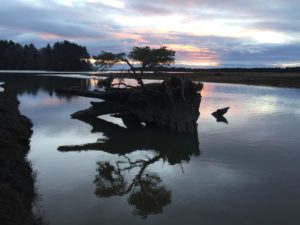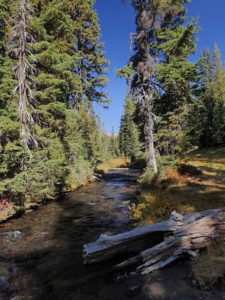In this article, learn…
- How trees stop air pollution
- How many species of trees exist
- How petrified wood is formed
- How trees produce food from sunlight and carbon dioxide
- How trees defy the laws of physics
- About the amazing structure of a tree’s trunk
- Air pollution and trees. Combined, New York City’s five million trees yearly remove an estimated two thousand tons of air pollutants, in addition to more than forty thousand tons of carbon dioxide from the air. Over an entire year, trees remove about .05 percent of the city’s air pollutants. It follows that people in well-treed neighborhoods breath easier than those were trees are absent. The more trees in a city the better (Haskell, p. 203.)
- Distribution of trees on our planet. Ninety percent of all tree species on earth live in tropical forests (Tudge, p. 27). The further you travel north or south from the tropics at the equator, the fewer the diversity of the species of trees you’ll find. The endless forests of Canada, for example, are dominated by only nine native species of trees including a few conifers and the quaking aspen. In the whole U.S., there are only about 620 native species of trees. India, which is much smaller than the U.S. has around 4,500 species of trees, and in one region of Peru where studies have been conducted within a 15 hectare area, 825 tree species have been identified. Tropical America (both North and South) have tens of thousands of species of trees (ibid., p. 279).
- How many trees are there? No one knows how many tree species exist on planet earth (Tudge, p. 27). Scientists’ best estimates are that there are approximately 60,000 species of trees (not including thousands of hybrids) in the world of which 600 are conifers. The total number of trees in the U.S. and Canada exceed 600 (ibid., p. 30). By comparison, the tropics of the New World from Mexico to Chili and Argentina contain tens of thousands of tree species with sometimes hundreds of species per square hectare (or 2.47 acres).
- Flowers of trees. Flowers are the principal way a botanist identifies the species of tree (Tudge, p. 32).
- Forests. A third of all land is covered in forest (Tudge, p. 19).
- Names plants—how determined. Taxonomy is the craft and science of classifying and naming living species (both plants and animals). The Bible records that being a taxonomist—the naming of earth’s animals—was one of the first tasks that Elohim (God) gave to the first humans (Genesis 2:19; Tudge, p. 49). The first job that the Creator gave to Adam and Eve was to procreate (be fruitful and multiply, Genesis 1:28), the second job was animal husbandry (Genesis 1:28), the third was that of a gardener (tend and keep the Garden of Eden, Genesis 2:15), and the fifth was to name the animals (Genesis 2:19). Today, names of plants and animals are called “scientific names” and are based on Latin and Greek words as well as geographical names, the names of people and even some other languages. Scientific names are based on a binomial system (e.g. Ursus arctos or grizzly bear and Acer sylvestris or Norway maple). The first generic name denotes the genus and the second name denotes the species (idid., p. 49).
- Petrified wood—how it is formed. Petrified wood can be formed when debris flows bury trees under meters of muddy earth. The standing wood soon rots away as the suffocated tree roots die. The mud from the debris flow is thick enough that the air’s oxygen is unable to reach the buried trunk, thus choking the bacteria that would otherwise have degraded the dead tree. With biological decomposition vastly slowed, the long process of turning wood into rock begins. Mineral rich water then begins to seep from the mud, soaking every cell of the buried tree with dissolved silica. Gradually, over hundreds of thousands of years, the silica crystallize, replacing the wood as it disintegrates. The growing crystals follow the shape of plant cells, creating a rocky imprint of the tree. After millions of years of suffusion with mineral-rich water, the tree becomes petrified (Haskell, p. 137).
- Photosynthesis. Many people take inspiration from trees and forests, and we often like to think of them as sanctuaries of peace and tranquility. But this is deceptive; forests are, in fact, ruthlessly competitive places, where trees—and even branches on the same trunk—are engaged in a life-and-death struggle for optimal position. The winner in this slow-motion race for space and light is determined by the tree or branch that photosynthesizes the fastest and best. Photosynthesis, the process of manufacturing usable energy (carbohydrates) from sunlight and carbon dioxide, takes place in a tree’s leaves or needles, and is an enormously complex process. (Vaillant, p. 192). This process involves the tree taking carbon dioxide or CO2 (what we exhale when we breath out), and then stripping the carbon atom from two oxygen atoms. The tree keeps the carbon and turns into food for itself, keeps some of the oxygen and then releases the rest not needed back into the atmosphere for humans and animals to breath all over again.
Photosynthesis is a true natural alchemy in that it is the process that allows a plant to, literally, build itself from air, water, and light from “nothing.” This is an awesome feat on any scale, but beggars comprehension when one considers the sheer mass of material that must be generated in order to “build” a sequoia, redwood, a Douglas fir or Sitka spruce tree (ibid.).
- Tropism in trees. The dictionary definition of tropism is “the turning of all or part of an organism in a particular direction in response to an external stimulus.” Geotropism is “the growth of the parts of plants with respect to the force of gravity. The upward growth of plant shoots is an instance of negative geotropism; the downward growth of roots is positive geotropism.” Phototropism is “the orientation of a plant or other organism in response to light, either toward the source of light (positive phototropism) or away from it (negative phototropism).”

From the point of view of physics, trees are rebels in that they spend their lives actively subverting the forces of gravity and entropy, two of the fundamental laws to which all earthly matter must ultimately answer. Trees express the ultimate defiance against these two laws through phototropism and negative geotropism; that is, they are programmed not only to seek out the shortest path to the noonday sun, but also to directly oppose the downward pull of gravity. This is why most trees tend to be straight, well-balanced, and relatively speaking, tall. What’s more, they pursue these radical objectives tirelessly, in some cases, for millennia. Viewed in this way, it could be argued that trees represent aspiration and ambition in their purest forms. Simply by daring to take root and grow, they bellow “We refute gravity and entropy thus” (Vaillant, pp. 191–192).
- Trunks of trees. When a plant is shaken, it grows more roots, investing proportionately more of its bodily resources in anchorage. Roots stiffen, making them more resistant to sway and bend. Their lengthwise strength increases also, like thickening ropes, adding extra strands of cellulose and lignin. Due to constant vibrations from traffic and wind whipping through narrow asphalt street jungles, a city street tree clings to the earth more tightly than its country cousins. Tree trunks also respond to movement by thickening trunk girth. Inside, the cells that compose wood grow more densely, with stouter walls. The old maxim, “What does not kill me, make me stronger” applies here. Wood is an embodied conversation between plant life, shudder of ground, and yaw of wind (Haskell, p. 190).
No matter how vigorous a tree may look on the outside, this is an illusion. Like the earth’s crust, the live portion of a tree is only a thin veil covering an otherwise lifeless mass. The inner part of a tree trunk (the heartwood) is like scaffolding and is similar to the structure of a coral reef. The trunk, branches and twigs of a tree are really a series of concentric tubes, each of which performs a specific function be it defensive, vascular or structural. The outer most “tube”—the bark—functions much like human skin in that it protects the tree from external attacks by animals, insects and fire. It also helps to contain fluids that keep the tree alive. Its thickness varies according to the needs of the tree. The bark and the “tubes,” in essence make the tree into a giant straw that sucks up water and nutrients from the soil with many subdividing lines. In a large tree, an individual molecule of water may take a week or more to travel from root to branch, and yet, such a tree can release hundreds of gallons of water into the air each day. Under the right conditions, a forest can generate its own fog and rain (Vaillant, pp. 192–193).
Sandwiched within a tree’s vascular system is the cambium, which is only one cell thick and which generates the tree’s wood in the form of annual growth rings. Inside the cambium (called the xylem) is the “dead” central core (or heartwood) of the tree. This part of the tree while serving as a sort of pillar to support the tree, it also holds and transports water. The cells in this column aren’t alive in the sense of being actively engaged in the construction and maintenance of the tree. Over the time, the water in these cells is replaced with a rigid, epoxy-like substance called lignin, which gives the tree its strength (Vaillant, p. 193).
Selected Bibliography of Sources
Arborists Certification Guide (ACG), by the International Society of Arboriculture; 2001
Conifers of the Pacific Slope, by Michael Edward Kauffmann, Backcountry Press, Kneeland, CA; 2013
Forest Trees of the Pacific Coast, by Willard A. Elliot, G.P. Putnam’s Sons, New York, N.Y.; 1938
The Hidden Life of Trees—The Illustrated Edition, by Peter Wohlleben, Greystone Books, Vancouver; 2018
The Golden Spruce, by John Vaillant, N.W. Norton & Co, New York, NY; 2005
The Secret Life Trees—How They Live and Why It Matter, by Colin Tudge, Penguin Books, New York, N.Y.; 2017
The Song of Trees—Stories From Nature’s Great Connectors, by David George Haskell, Penguin Books, New York, N.Y.; 2017
Trees to Know in Oregon, by Charles Ross, Oregon State University, Corvallis, OR; 1989


